List of Welsh dishes
| British cuisine |
|---|
 |
| National cuisines |
| Regional cuisines |
| Overseas/Fusion cuisine |
| People |
|
|
Welsh dishes as a whole are generally associated with simplicity.[1] Welsh cookery is thought to be similar to English cuisine in style. There are few written records of Welsh foods, recipes were instead held within families and passed down orally between the women of the family.[2] Those with the skills and inclination to write Welsh recipes, the upper classes, conformed to English styles and therefore would not have run their houses with traditional Welsh cuisine.[citation needed] Despite being poorly recorded, the traditional cookery of Wales does exist. It finds its roots in the day to day meals of peasant folk, unlike other cultures where the meals would start in the kitchens of the gentry and would be adapted for poorer plates.[3]
Welsh dishes
[edit]| Name | Image | Description |
|---|---|---|
| Bara brith | 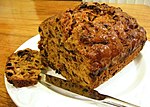
|
Bara Brith is a fruit loaf originating from rural Wales, where they used a mortar and pestle to grind the fresh sweet spices.[4] Historically it was made with yeast and butter, though recently it is likely to be made with bicarbonate of soda and margarine.[5] The fruit included would be dried raisins, currants, sultanas and candied peel,[6][7] which would be soaked in cold tea before cooking.[5] Generally served sliced with butter during afternoon tea,[8] it is often known as Welsh tea bread.[7] Bara Brith translates to "speckled bread",[5] but it is also known as teisen dorth in South Wales,[6] or as torta negra when Welsh settlers brought it to Argentina.[7] |
| Cawl | 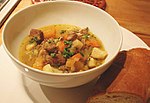
|
Cawl, pronounced "Kah-ool",[9] can be regarded as Wales' national dish.[10] Dating back to the 11th century,[10] originally it was a simple broth of meat (most likely lamb) and vegetables, it could be cooked slowly over the course of the day whilst the family was out working the fields.[11] It could be made in stages, over a number of days, first by making a meat stock, then by adding the vegetables on the following day.[10] Once cooked, the fat could be skimmed from the top of the pot, then it would be served as two separate dishes, first as a soup, then as a stew.[12] Leftovers could be topped up with fresh vegetables, sometimes over the course of weeks.[13]
During the 18th and 19th centuries, the amount of meat used in the broth was minimal, instead bulked out with potatoes.[14] Today, cawl would be much more likely to include beef or lamb for the meat,[15] and may be served with plain oatmeal dumplings or currant dumplings known as trollies.[15] Traditionally cawl would be eaten with a "specially-carved wooden spoon" and eaten from a wooden bowl.[11] |
| Cockles | very popular in Wales and served in a variety of ways although usually steamed. | |
| Crempog | 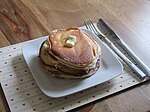
|
|
| Faggots | Welsh meatballs made from lamb or pig's liver, onions and a cereal binder | |
| Glamorgan sausage | 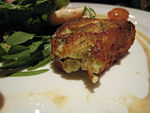
|
The Glamorgan sausage is a Welsh vegetarian sausage. It contains no meat or skin, instead it is made with cheese, generally Caerphilly, but sometimes cheddar, along with leek or spring onion.[19] This mixture is then coated in breadcrumbs and rolled into a sausage shape before cooking.[20][21] |
| Laverbread | 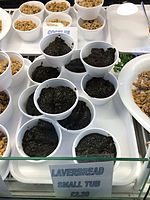
|
Laverbread, or Bara Lawr, is a Welsh speciality. It is made by cooking porphyra seaweed slowly over the course of up to ten hours[22] until it becomes a puree known as laver. The seaweed can also be cooked with oatmeal to make laverbread. It can be served with bacon and cockles as a breakfast dish,[23] or fried in to small patties.[24] Today, laverbread is commercially produced by washing in water, cooking for about 5 hours before chopping, salting and packaging.[25] |
| Leek soup | (Welsh: Cawl Cennin or Cawl Mamgu ("Granny's stew")). | |
| Lobscaws | a popular stew in Holyhead and Anglesey.
| |
| Pottage |
| |
| Roast lamb with laver sauce | ||
| Shepherd's pie | 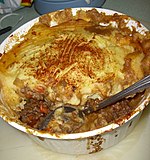
|
a type of lamb meat pie made with mashed potatoes, is often associated with Wales. |
| Tatws Pum Munud | 
|
(English: five minute potatoes), a traditional Welsh stew, made with potatoes, vegetables and bacon, and cooked on top of the stove. |
| Tatws Popty | 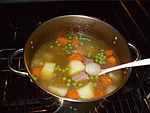
|
(English: oven potatoes), a traditional Welsh casserole, made with potatoes, vegetables and a joint of meat, and cooked in an oven. |
| Teisennau Tatws | (English: Potato Cakes), is a potato dish, served as an accompaniment — not a main dish in its own right. | |
| Welsh cake | 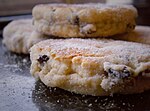
|
Welsh cakes, or pice ar y maen meaning "cakes on the stone", are small round spiced cakes, traditionally cooked on a bakestone, but more recently on a griddle. Once cooked, they can be eaten hot or cold, on their own or topped either with sugar or butter.[26] The dough which is mixed with raisins, sultanas and sometime currants,[27] is similar to shortbread, meaning they can have the consistency of biscuits when cooked on the griddle, and slightly more like a cake when cooked in the oven.[28] |
| Welsh rarebit | 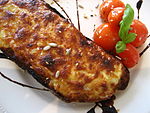
|
The predilection of the Welsh for roasted cheese led to the dish of Welsh rarebit, or Welsh rabbit, seasoned melted cheese poured over toasted bread.[29] The cheese would need to be a harder one, such as cheddar or similar. Referred to as Welsh rabbit as early as 1725, the name is not similar to the Welsh term caws pobi. Welsh folk rarely ate rabbit due to the cost and as land owners would not allow rabbit hunting, so the term is more likely a slur on the Welsh.[13][30][31] The name evolved from rabbit to rarebit, possibly to remove the slur from Welsh cuisine or due to simple reinterpretation of the word to make menus more pleasant.[32] |
References
[edit]- ^ Davidson 1981, p. 225.
- ^ Freeman 1996, p. 14.
- ^ Freeman 1996, p. 15.
- ^ Hensperger, Beth; Williams, Chuck (2002). "Welsh Bara Brith". In Williams, Chuck (ed.). Williams-Sonoma Collection: Bread (Illustrated ed.). Simon and Schuster. p. 84. ISBN 978-0-7432-2837-4. Retrieved 5 April 2016.
- ^ a b c Freeman 1996, p. 102.
- ^ a b Webb 2012, p. 74.
- ^ a b c Bain, Andrew (2009). Lonely Planet's 1000 Ultimate Experiences (Illustrated ed.). Lonely Planet. p. 291. ISBN 978-1-74179-945-3. Retrieved 5 April 2016.
- ^ Davidson 2014, p. 62.
- ^ Freeman 1996, p. 106.
- ^ a b c Webb 2012, p. 68.
- ^ a b c Davidson 1981, p. 224.
- ^ Cotter, Charis (2008). "Meats". One Thousand and One Foods (illustrated ed.). Anova Books. p. 545. ISBN 978-1-86205-785-2.
- ^ a b c Breverton, Terry (2012). "Food". Wales: A Historical Companion. Amberley Publishing Limited. ISBN 978-1-4456-0990-4.
- ^ Freeman 1996, p. 20.
- ^ a b Davidson 2014, p. 154.
- ^ Breverton, Terry (2015). The Tudor Kitchen: What the Tudors Ate & Drank. Amberley Publishing Limited. ISBN 978-1-4456-4875-0.
- ^ Tibbot, Sara Minwel (1991). Baking in Wales (Illustrated ed.). National Museum of Wales. p. 13. ISBN 978-0-7200-0346-8.
- ^ Mason, Laura (2009). "Teatime Treats". National Trust Farmhouse Cookbook. Anova Books. p. 218. ISBN 978-1-905400-81-2.
- ^ Ayto, John (2012). The Diner's Dictionary: Word Origins of Food and Drink (illustrated ed.). OUP Oxford. p. 153. ISBN 978-0-19-964024-9.
- ^ Minahan, James (2009). The Complete Guide to National Symbols and Emblems [2 Volumes] (illustrated ed.). ABC-CLIO. p. 572. ISBN 978-0-313-34497-8.
- ^ Allen, Gary (2015). Sausage: A Global History. Reaktion Books. ISBN 978-1-78023-555-4.
- ^ Hadoke, Mike; Kerndter, Fritz (2004). Langenscheidt Praxiswörterbuch Gastronomie: Englisch-Deutsch, Deutsch-Englisch. Langenscheidt Fachverlag. p. 90. ISBN 978-3-86117-199-7.
- ^ O'Connor, Kaori (December 2009). "The Secret History of 'The Weed of Hiraeth': Laverbread, Identity, and Museums in Wales". Journal of Museum Ethnography (22). Museum Ethnographers Group: 83. JSTOR 41417139.
- ^ Lewis-Stempel, John (2012). Foraging The Essential Guide to Free Wild Food. London: Hachette UK. ISBN 978-0-7160-2321-0.
- ^ Johansen, Mariela; Mouritsen, Jonas Drotner; Mouritsen, Ole G (2013). Seaweeds : edible, available & sustainable (illustrated ed.). Chicago, IL: University of Chicago Press. p. 152. ISBN 978-0-226-04436-1. Retrieved 7 April 2016.
- ^ Davidson 2014, p. 365.
- ^ Roufs, Timothy G.; Roufs, Kathleen Smyth (2014). Sweet Treats around the World: An Encyclopedia of Food and Culture: An Encyclopedia of Food and Culture. ABC-CLIO. p. 375. ISBN 978-1-61069-221-2.
- ^ Ayto, John (2012). The Diner's Dictionary: Word Origins of Food and Drink (illustrated ed.). OUP Oxford. p. 393. ISBN 978-0-19-964024-9.
- ^ National Trust (2007). Gentleman's Relish: A Compendium of English Culinary Oddities (illustrated ed.). Anova Books. p. 80. ISBN 978-1-905400-55-3.
- ^ Grumley-Grennan, Tony (2009). The Fat Man's Food & Drink Compendium. ISBN 978-0-9538922-3-5.
- ^ Imholtz, August; Tannenbaum, Alison; Carr, A. E. K (2009). Alice Eats Wonderland (Illustrated, annotated ed.). Applewood Books. p. 17. ISBN 978-1-4290-9106-0.
- ^ Reich, Herb (2013). Don't You Believe It!: Exposing the Myths Behind Commonly Believed Fallacies. Skyhorse Publishing Inc. ISBN 978-1-62873-324-2.
Bibliography
[edit]- Freeman, Bobby (1996). First Catch Your Peacock: Her Classic Guide to Welsh Food (illustrated, reprint, revised ed.). Y Lolfa. ISBN 978-0-86243-315-4. Retrieved 5 April 2016.
- Webb, Andrew (2012). Food Britannia. Random House. ISBN 978-1-4090-2222-0. Retrieved 5 April 2016.
- Davidson, Alan (2014). Jaine, Tom (ed.). The Oxford Companion to Food (Illustrated ed.). Oxford University Press. ISBN 978-0-19-967733-7. Retrieved 5 April 2016.
- Davidson, Alan (1981). Davidson, Alan (ed.). National & Regional Styles of Cookery: Proceedings : Oxford Symposium 1981 (Reprint ed.). Oxford Symposium. ISBN 978-0-907325-07-9.
